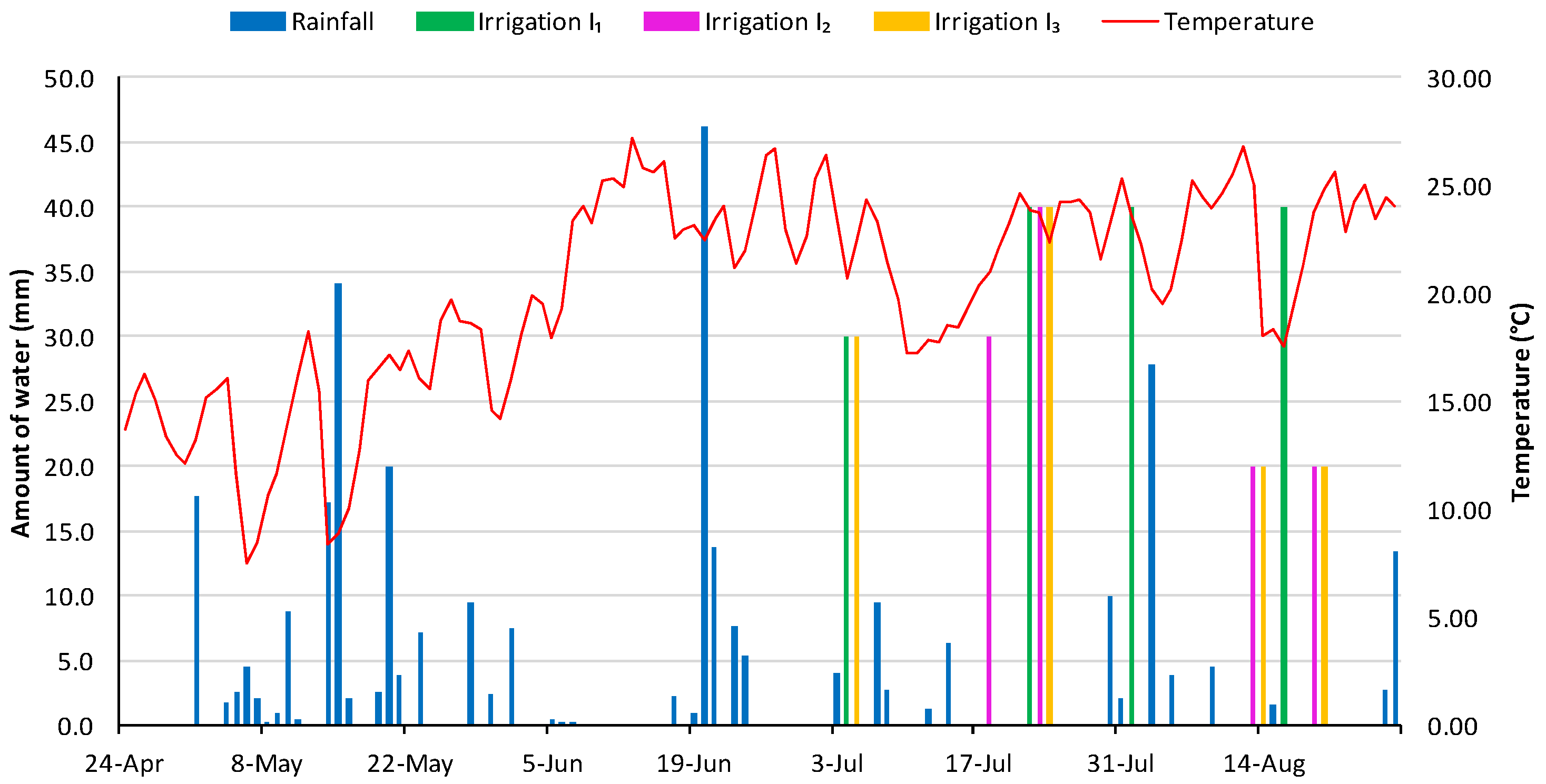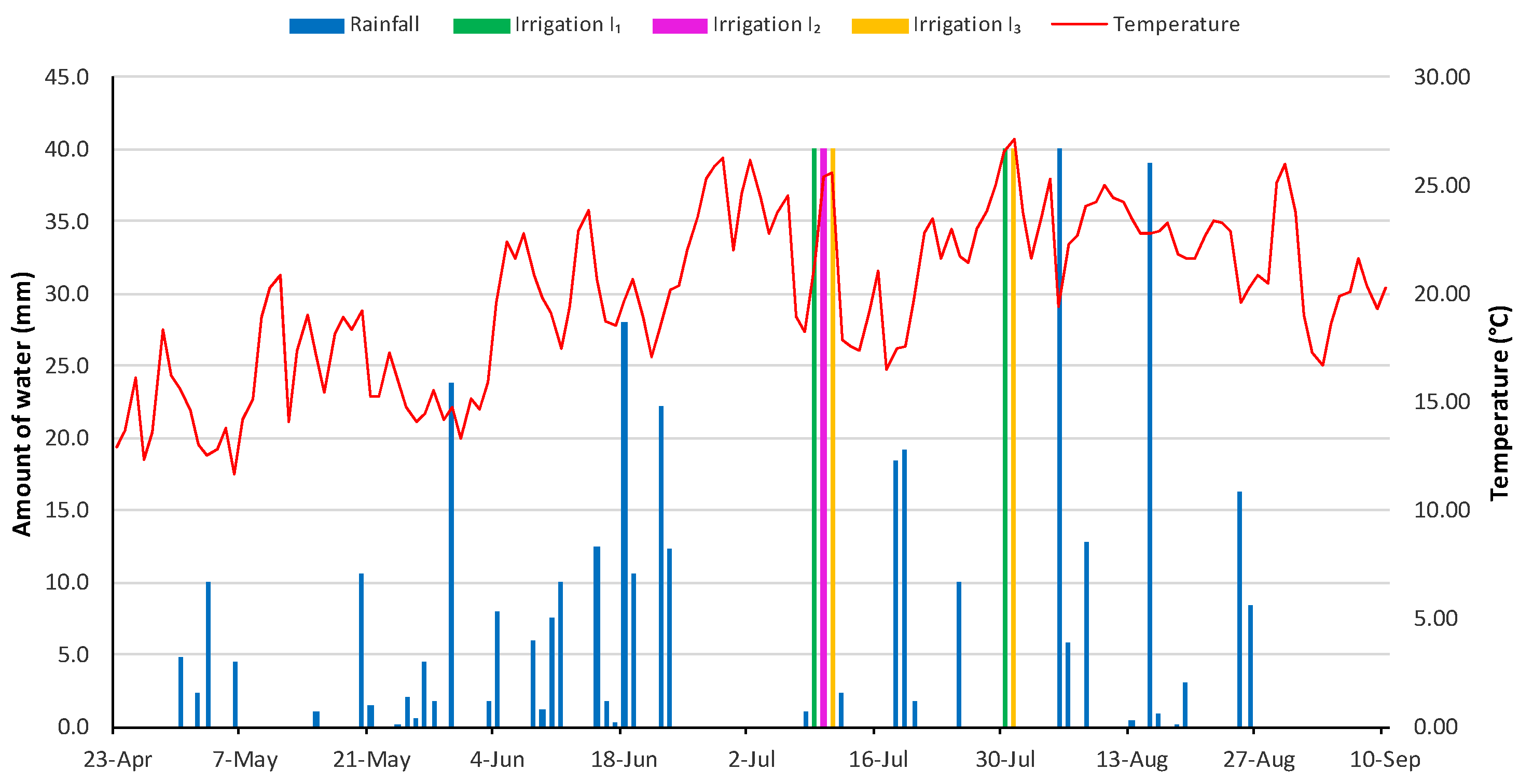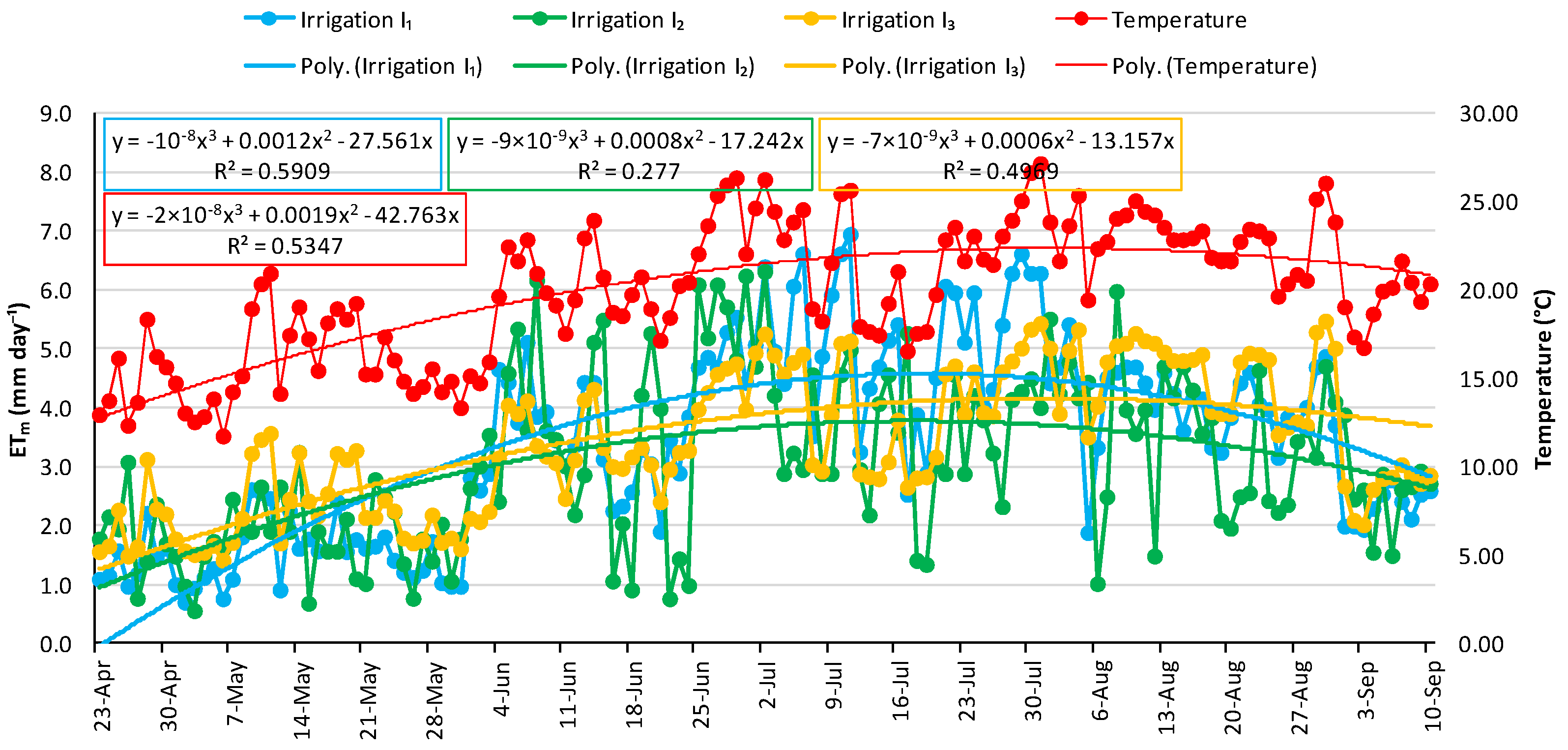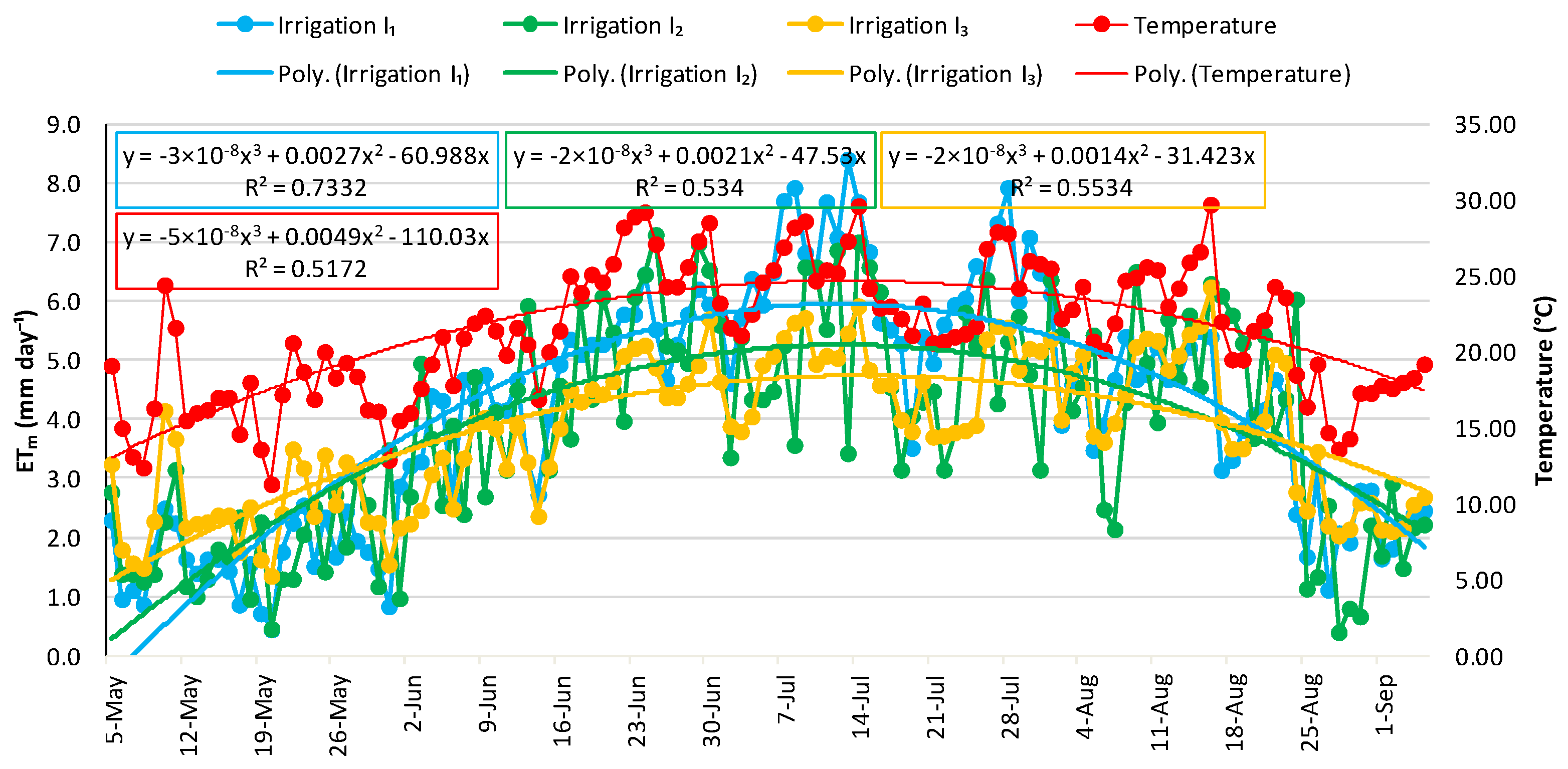Effect of Different ET-Based Irrigation Scheduling on Grain Yield and Water Use Efficiency of Drip Irrigated Maize
Abstract
1. Introduction
2. Materials and Methods
2.1. Site Description
2.2. Soil Properties
2.3. Crop Management, Experimental Design, and Irrigation Treatments
2.4. Sampling and Laboratory Analyses
2.5. Data Analyses
2.6. Statistical Analysis
3. Results
3.1. Weather Conditions and Applied Irrigation Water Amount
3.2. Effect of Irrigation on Yield and Selected Yield Components of Maize
3.2.1. Effect of Different ET-Based Irrigation Scheduling on Yield and Selected Yield Components of Maize
3.2.2. Effect of Surface and Shallow Subsurface Drip Irrigation on Yield and Selected Yield Components of Maize
3.3. Crop Water Use on Maize Evapotranspiration, Seasonal and Daily Values
3.4. Water Use Efficiency and Yield Response Factor of Maize
3.5. Yield Response Factor
4. Discussion
4.1. Weather Conditions and Applied Irrigation Water Amount
4.2. Effect of Irrigation on Yield of Maize
4.3. Effect of Different ET-Based Irrigation Scheduling on Yield of Maize
4.4. Effect of Surface and Shallow Subsurface Drip Irrigation on Yield of Maize
4.5. Maize Evapotranspiration
4.6. Water Use Efficiency and Yield Response Factor of Maize
5. Conclusions
Author Contributions
Funding
Institutional Review Board Statement
Informed Consent Statement
Data Availability Statement
Conflicts of Interest
References
- Food and Agriculture Organization. FAOSTAT; Statistics Division, FAO: Rome, Italy, 2022; Available online: https://www.fao.org/faostat/en/#data/QCL (accessed on 15 December 2022).
- Statistical Yearbook of Serbia. 2021. Available online: http://pod2.stat.gov.rs/ObjavljenePublikacije/G2008/Pdf/G20082003.pdf (accessed on 15 December 2022).
- Bošnjak, D. The problems of drought in the Vojvodina province and drought control measures. Ratar. Povrt. 2001, 35, 391–401. [Google Scholar]
- Pejić, B. Evapotranspiration and Morphological Characteristics of Corn Depending on the Depth of Soil Wetting and Their Relationships with Yield. Ph.D. Thesis, Agriculture Faculty, University of Novi Sad, Novi Sad, Serbia, 2000. (In Serbian). [Google Scholar]
- Pejić, B.; Maheshwari, B.L.; Šeremešić, S.; Stričević, R.; Pacureanu–Joita, M.; Rajić, M.; Ćupina, B. Water-yield relations of maize (Zea mays L.) in temperate climatic conditions. Maydica 2011, 56, 315–323. [Google Scholar]
- Djaman, K.; Irmak, S.; Rathje, W.R.; Martin, D.L.; Eisenhauer, D.E. Maize evapotranspiration, yield production functions, biomass, grain yield, harvest index, and yield response factors under full and limited irrigation. Trans. ASABE 2013, 56, 273–293. [Google Scholar]
- Zamora Re, M.I.; Dukes, M.D.; Hensley, D.; Graham, D.R. The effect of irrigation strategies and nitrogen fertilizer on maize growth and grain yield. Irrig. Sci. 2020, 38, 461–478. [Google Scholar] [CrossRef]
- Olivera-Guerra, L.; Merlin, O.; Er-Raki, S.; Khabba, S.; Escorihuela, M.J. Estimating the water budget components of irrigated crops: Combining the FAO-56 dual crop coefficient with surface temperature and vegetation index data. Agr. Water Manag. 2018, 208, 120–131. [Google Scholar] [CrossRef]
- Doorenbos, J.; Pruitt, W.O. Crop Water Requirements, 24; Irrigation and Drainage Paper; FAO: Rome, Italy, 1977. [Google Scholar]
- Allen, R.G.; Pereira, L.S.; Raes, D.; Smith, M. Crop Evapotranspiration–Guidelines for Computing Crop Water Requirements, 56; Irrigation and Drainage Paper; FAO: Rome, Italy, 1998. [Google Scholar]
- Hargreaves, G.H.; Allen, R.G. History and evaluation of Hargreaves evapotranspiration equation. J. Irrig. Drain Eng. 2003, 129, 53. [Google Scholar] [CrossRef]
- Ertek, A. Importance of pan evaporation for irrigation scheduling and proper use of crop-pan coefficient (Kcp), crop coefficient (Kc) and pan coefficient (Kp). Afr. J. Agric. Res. 2011, 6, 6706–6718. [Google Scholar]
- Sattari, M.T.; Ahmadifar, V.; Delirhasannia, R.; Apaydin, H. Estimation of the pan evaporation coefficient in cold and dry climate conditions via the M5 regression tree model. Atmosfera 2021, 34, 289–300. [Google Scholar]
- Bošnjak, D. Evaporation from free water surface as a base for irrigation scheduling and its relationship to ETP of maize and soybean. J. Agric. Res. 1983, 44, 323–344. (In Serbian) [Google Scholar]
- Ertek, A.; Bolat, S. Growth and yield of pepper (Capsicum annuum L.) under root zone restriction. J. Agric. Sci. Technol. 2016, 2, 555–599. [Google Scholar] [CrossRef]
- Vučić, N. Bioclimatic coefficients and watering regime of plants-theory and practical application. Vodoprivreda 1971, 6–8, 463–467. (In Serbian) [Google Scholar]
- Dragović, S.; Verešbaranji, I.; Maksimović, L.; Labat, A. Determining irrigation schedule by the analysis of soil water balance. Ratar. Povrt. 1991, 19, 83–96. [Google Scholar]
- Mguidiche, A.B.; Mhamdi, D.; Khila, B.; Boujelben, A. Subsurface drip irrigation of potato under Tunisian climatic condition. Scantia Agric. 2014, 1, 103–109. [Google Scholar]
- Patel, N.; Rajput, B.S. Effect of subsurface drip irrigation on onion yield. Irrig. Sci. 2009, 27, 97–108. [Google Scholar] [CrossRef]
- Irmak, S.; Djaman, K.; Rudnick, D.R. Effect of full and limited irrigation amount and frequency on subsurface drip-irrigated maize evapotranspiration, yield, water use efficiency and yield response factors. Irrig. Sci. 2016, 34, 271–286. [Google Scholar] [CrossRef]
- Kalfountzos, D.; Alexiou, I.; Kotsopouloss, S.; Zavakos, G.; Vyrlas, P. Effect of subsurface drip irrigation on Cotton plantations. Water Resour. Manag. 2007, 21, 1341–1351. [Google Scholar] [CrossRef]
- Wang, S.; Jiao, X.; Guo, W.; Lu, J.; Bai, Y.; Wang, L. Adaptability of shallow subsurface drip irrigation of alfalfa in an arid desert area of Northern Xinjiang. PLoS ONE 2018, 13, e0195965. [Google Scholar] [CrossRef]
- Samardžić, S.; Pejić, B.; Bajić, I.; Ćirić, V.; Aksić, M.; Vojnov, B. Water–yield relations of processing potato under surface and shallow subsurface drip irrigation in temperate climatic environment. Agricult. Forest. 2022, 68, 89–105. [Google Scholar]
- Karam, F.; Karaa, K.; Tarabey, N. Effects of deficit irrigation on yield and water use efficiency of some crops under semi-arid conditions of the Bekaa valley of Lebanon. In Water Use Efficiency and Water Productivity: WASAMED Project; Lamaddalena, N., Shatanawi, M., Todorovic, M., Bogliotti, C., Albrizio, R., Eds.; Options Méditerranéennes: Série B. Etudes et Recherches; n. 57; CIHEAM: Bari, Italy, 2007; pp. 137–151. [Google Scholar]
- Zhang, G.; Ming, B.; Shen, D.; Xie, R.; Hou, P.; Xue, J.; Wang, K.; Li, S. Optimizing grain yield and water use efficiency based on the relationship between leaf area index and evapotranspiration. Agriculture 2021, 11, 313. [Google Scholar] [CrossRef]
- Payero, J.O.; Melvin, S.R.; Irmak, S.; Tarkalson, D. Yield response of corn to deficit irrigation in a semiarid climate. Agr. Water Manag. 2006, 84, 101–112. [Google Scholar] [CrossRef]
- Kobossi, K.; Kaveh, F. Sensitivity analysis of Doorenbos and Kassam (1979) crop water production function. Afr. J. Agric. Res. 2010, 5, 2399–2417. [Google Scholar]
- Rossi, R. Irrigation in EU Agriculture. European Parliamentary Research Service. Available online: https://www.europarl.europa.eu/RegData/etudes/BRIE/2019/644216/EPRS_BRI(2019)644216_EN.pdf (accessed on 9 May 2023).
- Pejić, B.; Mačkić, K.; Simić, D.; Bajić, I.; Sikora, V.; Bekavac, G.; Kresović, B. Effect of irrigation on yield, water productivity and leaf area index of maize. Ann. Agron. 2020, 44, 187–193. (In Serbian) [Google Scholar]
- Howell, A. Enhancing water use efficiency in irrigated agriculture. J. Agron. 2001, 93, 281–289. [Google Scholar] [CrossRef]
- Wang, Z.; Zerihum, D.; Feyen, J. General irrigation efficiency for field water management. Agr. Water Manag. 1996, 30, 123–132. [Google Scholar] [CrossRef]
- Pejić, B.; Bajić, I.; Mačkić, K.; Bugarski, D.; Vlajić, S.; Takač, A.; Aksić, M. Irrigation scheduling strategies for paper based on evaporation and reference evapotranspiration. Acta Agric. Serb. 2021, 26, 69–76. [Google Scholar] [CrossRef]
- Mihailović, D.T.; Lalić, B.; Drešković, N.; Mimić, G.; Djurdjević, V.; Jančić, M. Climate change effects on crop yields in serbia and related shifts of köppen climate zones under the SRES-A1B and SRES-A2. Int. J. Climatol. 2014, 35, 3320–3334. [Google Scholar] [CrossRef]
- Tommerup, E.C. The Field Description of the Physical Properties of Soils; First Commission of Commission I–Soil Physics–of the International Society of Soil Science; International Society of Soil Science: Versailles, France, 1934; pp. 155–158. [Google Scholar]
- Djaman, K.; Irmak, S. Soil water extraction patterns and crop, irrigation, and evapotranspiration water use efficiency of maize under full and limited irrigation and rainfed settings. ASABE 2012, 55, 1223–1238. [Google Scholar] [CrossRef]
- Bos, M.G. Summary of ICID Definitions of Irrigation Efficiency. ICID Bull 1985, 34, 28–31. [Google Scholar]
- Doorenbos, J.; Kassam, A.K. Yield Response to Water, 33; Irrigation and Drainage Paper; FAO: Rome, Italy, 1979. [Google Scholar]
- Kresović, B.; Tapanarova, A.; Tomić, Z.; Životić, L.; Vujović, D.; Sredojević, Z.; Gajić, B. Grain yield and water use efficiency of maize as influenced by different irrigation regimes through sprinkler irrigation under temperate climate. Agr. Water Manag. 2016, 169, 34–43. [Google Scholar] [CrossRef]
- Rudnick, D.R.; Irmak, S.; Djaman, K.; Sharma, V. Impact of irrigation and nitrogen fertilizer rate on soil water trends and maize evapotranspiration during the vegetative and reproductive periods. Agr. Water Manag. 2017, 191, 77–84. [Google Scholar] [CrossRef]
- Wu, D.; Xu, X.; Chen, Y.; Shao, H.; Sokolowski, E.; Mi, G. Effect of different drip fertigation methods on maize yield, nutrient and water productivity in two-soils in Northeast China. Agr. Water Manag. 2019, 213, 200–211. [Google Scholar] [CrossRef]
- Çakir, R. Effect of water stress at different development stages on vegetative and reproductive growth of corn. Field Crops Res. 2004, 89, 1–16. [Google Scholar] [CrossRef]
- Mengu, G.P.; Ozgurel, M. An evaluation water-yield relations in maize (Zea mays L.) in Turkey. Pakistan J. Biol. Sci. 2008, 11, 517–524. [Google Scholar] [CrossRef][Green Version]
- Kusku, H.; Karasu, A.; Oz, M.; Demir, A.O.; Turgut, I. Effet of irrigation amounts applied with drip irrigation on maize evapotranspiration, yield, water use efficiency and net return in a sab-humid climate. Turk. J. Field Crops 2013, 18, 13–19. [Google Scholar]
- Payero, J.O.; Tarkalson, D.D.; Irmak, S.; Davison, D.; Petersen, J.L. Effect of irrigation amounts applied with subsurface drip irrigation on corn evapotranspiration, yield, water use efficiency, and dry matter production in a semiarid climate. Agric. Water Manag. 2008, 95, 895–908. [Google Scholar] [CrossRef]
- Wang, F.; Xiao, J.; Ming, B.; Xie, R.; Wang, K.; Hou, P.; Liu, G.; Zhang, G.; Chen, J.; Liu, W.; et al. Grain yields and evapotranspiration dynamics of drip-irrigated maize under high plant density across arid to semi-humid climates. Agr. Water Manag. 2021, 247, 106726. [Google Scholar] [CrossRef]
- Sonbol, H.A.; El Hadidi, E.M.; Saied, M.M.; Abo El-Soud, H.M. Comparison of some types of surface and drip irrigation systems on maize crop. J. Agric. Sci. Mansoura Univ. 2009, 34, 7199–7210. [Google Scholar] [CrossRef]
- Pejić, B.; Mačkić, K.; Sikora, V.; Maksimović, L.; Kresović, B.; Gajić, B.; Djalović, I. Water-yield relations of drip irrigated maize in temperate climatic conditions. In Proceedings of the 2nd International and 14th National Congres of Soil Science Society of Serbia, Novi Sad, Serbia, 25–28 September 2017; pp. 258–265. [Google Scholar]
- Djaman, K.; O’Neill, M.; Owen, C.K.; Smeal, D.; Koudahe, K.; West, M.; Allen, S.; Lombard, K.; Irmak, S. Crop evapotranspiration, irrigation water requirement and water productivity of maize from meteorological data under semiarid climate. Water 2018, 10, 405. [Google Scholar] [CrossRef]
- Payero, J.O.; Klocke, N.L.; Schneekloth, J.P.; Davison, D.R. Comparison of irrigation strategies for surface-irrigated corn in West Central Nebraska. Irrig. Sci. 2006, 24, 257–265. [Google Scholar] [CrossRef]
- Cupina, B.; Krstic, D.; Mikic, A.; Eric, P.; Vuckovic, S.; Pejic, B. The effect of field pea (Pisum sativum L.) companion crop management on red clover (Trifolium pratense L.) establishment and productivity. Turk. J. Agric. For. 2010, 34, 275–283. [Google Scholar] [CrossRef]
- Vojnov, B.; Jaćimović, G.; Šeremešić, S.; Pezo, L.; Lončar, B.; Krstić, Đ.; Vujić, S.; Ćupina, B. The effects of winter cover crops on maize yield and crop performance in semiarid conditions-artificial neural network approach. Agronomy 2022, 12, 2670. [Google Scholar] [CrossRef]
- Viets, F.G. Fertilizers and the efficient use of water. Adv. Agron. 1962, 14, 223–264. [Google Scholar]
- Pejić, B.; Mačkić, K.; Koza, M.; Jančić-Tovjanin, M.; Gajićb, B.; Aksić, M. The effect of different irrigation scheduling regimes on tomato (Lycopersicon esculentum Mill.) yield under drip irrigation system. Ann. Agron. 2019, 43, 17–25. [Google Scholar]
- Videnović, Ž.; Stefanović, L.; Simić, M.; Kresović, B. Trends in maize growing practices in Serbia. Herbologia 2007, 8, 85–94. [Google Scholar]
- Yazar, A.; Gökçel, F.; Sezen, M.S. Corn yield response to partial rootzone drying and deficit irrigation strategies applied with drip system. Plant Soil Environ. 2009, 55, 494–503. [Google Scholar] [CrossRef]
- Kang, S.; Gu, B.; Du, T.; Zhang, J. Crop coefficient and ratio of transpiration to evapotranspiration of winter wheat and maize in a semi-humid region. Agric. Water Manag 2003, 3, 239–254. [Google Scholar] [CrossRef]
- Greaves, G.E.; Wang, Y.M. Yield response, water productivity, and seasonal water production functions for maize under deficit irrigation water management in southern Taiwan. Plant Prod. Sci. 2017, 20, 353–365. [Google Scholar] [CrossRef]
- Kipkorir, E.C.; Massawe, D.R. Seasonal water production functions and yield response factors for maize and onion in Perkerra, Kenya. Agric. Water Manag. 2003, 56, 229–240. [Google Scholar] [CrossRef]
- Dağdelen, N.; Yilmaz, E.; Sezgin, F.; Gürbüz, T. Water-yield relation and water use efficiency of cotton (Gossypium hirsutum L.) and second crop corn (Zea mays L.) in western Turkey. Agric. Water Manag. 2006, 82, 63–85. [Google Scholar] [CrossRef]
- Oktem, A. Effect of water shortage on yield, and protein and mineral compositions of drip-irrigated sweet corn in sustainable agricultural systems. Agric. Water Manag. 2008, 95, 1003–1010. [Google Scholar] [CrossRef]










| Soil depth (m) | 0.4 |
| Textural Status, (Sand/Clay/Silt) (%) | 41/34/25 |
| Soil Water Capacity (33 kPa) (mas. %) | 26.93 |
| Lento Capillary Moisture (625 kPa) (mas. %) | 16.61 |
| Wilting Point (1500 kPa) (mas. %) | 12.65 |
| Soil Bulk Density (g cm−3) | 1.30 |
| Specific Gravity (g cm−3) | 2.66 |
| Total Porosity (vol. %) | 49.13 |
| Readily Available Water (mm) | 54.5 |
| pH (KCl/H2O) | 7.28/8.17 |
| Carbonates, CaCO3 (%) | 6.01 |
| Organic matter, Humus (%) | 2.9 |
| N (%) | 0.19 |
| P2O5 (mg 100 g−1) | 29.77 |
| K2O (mg 100 g−1) | 30.43 |
| Months | kc | k | lc |
|---|---|---|---|
| May | <15.1 °C—0.3 15.1–18.3 °C—0.4 >18.3 °C–0.5 | 0.42 | <15.1 °C—0.12 15.1–18.3 °C—0.14 >18.3 °C—0.17 |
| Jun | <18.4 °C—0.7 18.4–21 °C—0.8 >21 °C—0.85 | 0.75 | <18.4 °C—0.14 18.4–21 °C—0.16 >21 °C—0.18 |
| July | <20.1 °C—1.05 20.1–22.7 °C—1.1 >22.7 °C—1.2 | 0.70 | <20.1 °C—0.16 20.1–22.7 °C—0.18 >22.7 °C—0.20 |
| August | <19.2 °C—0.8 19.2–22.4 °C—0.85 >22.4 °C—0.9 | 0.67 | <19.2 °C—0.15 19.2–22.4 °C—0.18 >22.4 °C—0.21 |
| September | <15.4 °C—0.5 15.4–18.3 °C—0.55 >18.3 °C—0.6 | 0.63 | <15.4 °C—0.10 15.4–18.3 °C—0.12 >18.3 °C—0.14 |
| 2019 | 2020 | 2021 | |||||||||||||
|---|---|---|---|---|---|---|---|---|---|---|---|---|---|---|---|
| I1 | I2 | I3 | I0 | Mean | I1 | I2 | I3 | I0 | Mean | I1 | I2 | I3 | I0 | Mean | |
| Yield (t ha−1) | I1–I3 | I1–I3 | I1–I3 | ||||||||||||
| S1 | 10.89 a | 8.38 c | 8.75 c | 7.28 d | 9.34 A | 12.89 a | 11.11 bc | 12.20 ab | 10.54 c | 12.07 A | 9.40 b | 9.57 b | 8.98 b | 5.98 c | 9.32 B |
| S2 | 10.57 a | 9.48 b | 8.56 c | 7.28 d | 9.54 A | 11.05 bc | 11.13 bc | 11.85 abc | 10.54 c | 11.34 A | 10.20 ab | 10.90 a | 8.75 b | 5.98 c | 9.95 A |
| Mean | 10.73 A | 8.93 B | 8.65 B | 7.28 C | 11.97 A | 11.12 AB | 12.02 A | 10.54 B | 9.80 A | 10.24 A | 8.86 C | 5.98 D | |||
| LSD(0.05) | ET 0.4 | S 0.2 | ET × S 0.5 | ET 1.1 | S 0.8 | ET × S 1.6 | ET 0.46 | S 0.52 | ET × S 0.86 | ||||||
| Weight of ear (g) | |||||||||||||||
| S1 | 331.8 a | 284.4 b | 280.5 b | 237.3 c | 298.9 A | 336.4 a | 335.2 a | 340.2 a | 294.7 d | 337.3 A | 299.5 a | 314.9 a | 312.4 a | 234.9 b | 290.4 A |
| S2 | 305.4 b | 282.6 b | 283.9 b | 237.3 c | 290.6 A | 317.5 bc | 329.0 ab | 307.4 cd | 294.7 d | 318.0 B | 298.3 a | 302.6 a | 294.0 a | 234.9 b | 282.4 A |
| Mean | 318.6 A | 283.5 B | 282.2 B | 2.373 C | 326.9 A | 332.1 A | 323.8 A | 294.7 B | 298.9 A | 308.7 A | 303.2 A | 234.9 B | |||
| LSD(0.05) | ET 23.3 | S 8.7 | ET × S 26.1 | ET 8.8 | S 10.5 | ET × S 17.2 | ET 19.6 | S 14.3 | ET × S 27.9 | ||||||
| Number of grains per ear | |||||||||||||||
| S1 | 580 a | 551 ab | 584 a | 529 b | 572 A | 815 a | 768 ab | 773 ab | 706 c | 785 A | 679 a | 692 a | 673 a | 598 b | 681 A |
| S2 | 558 ab | 544 ab | 570 ab | 529 b | 557 A | 754 bc | 754 bc | 734 bc | 706 c | 747 B | 635 ab | 693 a | 648 ab | 598 b | 658 A |
| Mean | 569 A | 548 AB | 577 A | 529 B | 785 A | 761 AB | 754 AB | 706 B | 657 A | 692 A | 661 A | 598 B | |||
| LSD(0.05) | ET 40.1 | S 19.4 | ET × S 48.1 | ET 55.5 | S 14.9 | ET × S 59.0 | ET 44.9 | S 28.3 | ET × S 59.5 | ||||||
| Weight of grains per ear (g) | |||||||||||||||
| S1 | 277.7 a | 236.6 bc | 235.1 bc | 199.0 d | 249.8 A | 273.8 a | 271.7 a | 275.7 a | 239.2 c | 273.7 A | 261.2 a | 263.6 a | 264.1 a | 201.0 b | 247.5 A |
| S2 | 255.8 b | 238.4 bc | 233.9 c | 199.0 d | 242.7 A | 257.2 b | 267.0 ab | 249.1 bc | 239.2 c | 257.8 B | 260.5 a | 258.5 a | 255.8 a | 201.0 b | 243.9 A |
| Mean | 266.7 A | 237.5 B | 234.5 B | 199.0 C | 265.5 AB | 269.3 A | 262.4 B | 239.2 C | 260.8 A | 261.1 A | 260.0 A | 201.0 B | |||
| LSD(0.05) | ET 19.3 | S 7.2 | ET × S 21.6 | ET 6.8 | S 7.9 | ET × S 13.0 | ET 28,5 | S 4.2 | ET × S 29.0 | ||||||
| Weight of 1000 grains (g) | |||||||||||||||
| S1 | 504.7 a | 444.6 b | 415.0 cd | 388.5 d | 438.2 A | 350.6 a | 364.5 a | 371.9 a | 350.6 a | 362.3 A | 440.4 a | 429.3 ab | 409.7 ab | 371.4 b | 412.7 A |
| S2 | 485.0 a | 450.6 b | 423.5 bc | 388.5 d | 436.9 A | 358.2 a | 364.0 a | 360.8 a | 350.6 a | 361.0 A | 401.5 ab | 408.7 ab | 415.3 ab | 371.4 b | 399.2 A |
| Mean | 494.9 A | 447.6 B | 419.3 C | 388.5 D | 354.4 A | 364.2 A | 366.4 A | 350.6 A | 420.9 A | 419.0 AB | 412.5 AB | 371.4 B | |||
| LSD(0.05) | ET 18.1 | S 14.8 | ET × S 27.4 | ET 20.0 | S 8.9 | ET × S 23.4 | ET 49.0 | S 25.1 | ET × S 59.9 | ||||||
| Elements | From Sowing to Emergence (S-E) | From Emergence to 7–8 Leaves (E-V7-8) | From 7–8 Leaves to Silking (V7-8-VS) | From Silking to Physiological Maturity (VS-R6) | The Entire Season Total/Average (S-R6) | ||||||||||
|---|---|---|---|---|---|---|---|---|---|---|---|---|---|---|---|
| 24.IV–03.V | 04.V–14.VI | 15.VI–14.VII | 15.VII–27.VIII | 24.IV–27.VIII | |||||||||||
| I1 | I2 | I3 | I1 | I2 | I3 | I1 | I2 | I3 | I1 | I2 | I3 | I1 | I2 | I3 | |
| ETo (mm) | 39 | - | - | 159 | - | - | 156 | - | - | 225 | - | - | 579 | - | - |
| Eo (mm) | - | 38 | - | - | 160 | - | - | 151 | - | - | 289 | - | - | 638 | - |
| ETm (mm) | 13 | 16 | 18 | 90 | 88 | 110 | 144 | 110 | 122 | 214 | 197 | 197 | 461 | 411 | 447 |
| ETm (%) | 2.8 | 3.9 | 4.0 | 19.5 | 21.4 | 24.6 | 31.2 | 26.8 | 27.3 | 46.5 | 47.9 | 44.1 | 100 | 100 | 100 |
| Duration (days) | 10 | 42 | 30 | 44 | 126 | ||||||||||
| ETd (mm) | 1.3 | 1.6 | 1.8 | 2.1 | 2.1 | 2.6 | 4.8 | 3.7 | 4.1 | 4.9 | 4.8 | 4.5 | 3.7 | 3.7 | 3.6 |
| Rainfall (mm) | 18 | 129 | 100 | 66 | 313 | 313 | 313 | ||||||||
| Temperature (°C) | 14.3 | 17.1 | 22.4 | 22.8 | 20.1 | 20.1 | 20.1 | ||||||||
| ∆ | −3 | −6 | - | +39 | −15 | +19 | −44 | −10 | −22 | −10 | −44 | −18 | - | - | - |
| r (mm) | 21 | 21 | 21 | 18 | 15 | 21 | 54 | 54 | 40 | 10 | 44 | 18 | - | - | - |
| ETa (mm) | 13 | 16 | 18 | 90 | 88 | 110 | 144 | 110 | 122 | 76 | 110 | 84 | 323 | 324 | 334 |
| d (mm) | 0 | 0 | 0 | 0 | 0 | 0 | 0 | 0 | 0 | 138 | 87 | 113 | 138 | 87 | 113 |
| s (mm) | 0 | 0 | 0 | 3 | 2 | 0 | 0 | 0 | 0 | 0 | 0 | 0 | 3 | 2 | 0 |
| Irrigation (mm) | - | - | - | - | - | - | 30 | - | 30 | 120 | 110 | 80 | 150 | 110 | 110 |
| Elements | From Sowing to Emergence (S-E) | From Emergence to 7–8 Leaves (E-V7-8) | From 7–8 Leaves to Silking (V7-8-VS) | From Silking to Physiological Maturity (VS-R6) | The Entire Season Total/Average (S-R6) | ||||||||||
|---|---|---|---|---|---|---|---|---|---|---|---|---|---|---|---|
| 23.IV–02.V | 03.V–25.VI | 26.VI–11.VII | 12.VII–10.IX | 23.IV–10.IX | |||||||||||
| I1 | I2 | I3 | I1 | I2 | I3 | I1 | I2 | I3 | I1 | I2 | I3 | I1 | I2 | I3 | |
| ETo (mm) | 36 | - | - | 222 | - | - | 87 | - | - | 280 | - | - | 625 | - | - |
| Eo (mm) | - | 42 | - | - | 234 | - | - | 100 | - | - | 311 | - | - | 687 | - |
| ETm (mm) | 13 | 18 | 19 | 130 | 135 | 145 | 86 | 72 | 71 | 249 | 205 | 246 | 478 | 430 | 481 |
| ETm (%) | 2.7 | 4.2 | 4.0 | 27.2 | 31.4 | 30.1 | 18.0 | 16.7 | 14.8 | 52.1 | 47.7 | 51.1 | 100 | 100 | 100 |
| Duration (days) | 10 | 54 | 16 | 61 | 141 | ||||||||||
| ETd (mm) | 1.3 | 1.8 | 1.9 | 2.4 | 2.5 | 2.7 | 5.4 | 4.5 | 4.4 | 4.1 | 3.4 | 4.0 | 3.4 | 3.1 | 3.4 |
| Rainfall (mm) | 7 | 183 | 1 | 179 | 370 | 370 | 370 | ||||||||
| Temperature (°C) | 14.6 | 11.7 | 23.7 | 21.7 | 19.9 | 19.9 | 19.9 | ||||||||
| ∆ | −6 | −11 | −12 | +53 | +48 | +38 | −54 | −54 | −53 | - | - | - | - | - | - |
| r (mm) | 27 | 27 | 27 | 21 | 16 | 15 | 54 | 54 | 53 | 0 | 0 | 0 | - | - | - |
| ETa (mm) | 13 | 18 | 19 | 130 | 135 | 145 | 55 | 55 | 54 | 179 | 179 | 179 | 377 | 387 | 397 |
| d (mm) | 0 | 0 | 0 | 0 | 0 | 0 | 31 | 17 | 17 | 70 | 26 | 67 | 101 | 43 | 84 |
| s (mm) | 0 | 0 | 0 | 20 | 10 | 0 | 0 | 0 | 0 | 0 | 0 | 0 | 20 | 10 | 0 |
| Irrigation (mm) | - | - | - | - | - | - | 40 | 40 | 40 | 40 | - | 40 | 80 | 40 | 80 |
| Elements | From Sowing to Emergence (S-E) | From Emergence to 7–8 Leaves (E-V7-8) | From 7–8 Leaves to Silking (V7-8-VS) | From Silking to Physiological Maturity (VS-R6) | The Entire Season Total/Average (S-R6) | ||||||||||
|---|---|---|---|---|---|---|---|---|---|---|---|---|---|---|---|
| 05.V–11.V | 12.V–15.VI | 16.VI–10.VII | 11.VII–05.IX | 05.V–05.IX | |||||||||||
| I1 | I2 | I3 | I1 | I2 | I3 | I1 | I2 | I3 | I1 | I2 | I3 | I1 | I2 | I3 | |
| ETo (mm) | 28 | - | - | 149 | - | - | 155 | - | - | 273 | - | - | 605 | - | - |
| Eo (mm) | - | 32 | - | - | 159 | - | - | 181 | - | - | 352 | - | - | 724 | - |
| ETm (mm) | 12 | 14 | 18 | 90 | 90 | 96 | 146 | 132 | 119 | 266 | 237 | 238 | 514 | 473 | 471 |
| ETm (%) | 2.3 | 3.0 | 3.8 | 17.5 | 19.0 | 20.4 | 28.4 | 27.9 | 25.3 | 51.8 | 50.1 | 50.5 | 100 | 100 | 100 |
| Duration (days) | 7 | 35 | 25 | 57 | 124 | ||||||||||
| ETd (mm) | 1.7 | 2.0 | 2.6 | 2.6 | 2.6 | 2.7 | 5.8 | 5.3 | 4.8 | 4.7 | 4.2 | 4.2 | 4.1 | 3.8 | 3.8 |
| Rainfall (mm) | 0 | 49 | 2 | 143 | 194 | 194 | 194 | ||||||||
| Temperature (°C) | 17.4 | 17.9 | 25.4 | 22.3 | 21.4 | 21.4 | 21.4 | ||||||||
| ∆ | −12 | −14 | −18 | −20 | −18 | −14 | - | - | - | - | - | - | - | - | - |
| r (mm) | 32 | 32 | 32 | 20 | 18 | 14 | 0 | 0 | 0 | 0 | 0 | 0 | - | - | - |
| ETa (mm) | 12 | 14 | 18 | 69 | 67 | 63 | 2 | 2 | 2 | 143 | 143 | 143 | 226 | 226 | 226 |
| d (mm) | 0 | 0 | 0 | 21 | 23 | 33 | 144 | 130 | 117 | 123 | 94 | 95 | 288 | 247 | 245 |
| s (mm) | 0 | 0 | 0 | 0 | 0 | 0 | 0 | 0 | 0 | 0 | 0 | 0 | 0 | 0 | 0 |
| Irrigation (mm) | - | - | - | 20 | 20 | 20 | 110 | 110 | 110 | 110 | 80 | 80 | 240 | 210 | 210 |
| Year | Type of Drip Irrigation | ET-Based Irrigation Scheduling | IWUE | ETWUE |
|---|---|---|---|---|
| 2019 | S1 | I1 | 2.41 | 2.62 |
| I2 | 1.00 | 1.26 | ||
| I3 | 1.34 | 1.30 | ||
| S2 | I1 | 2.19 | 2.38 | |
| I2 | 2.01 | 2.54 | ||
| I3 | 1.17 | 1.14 | ||
| 2020 | S1 | I1 | 2.94 | 2.33 |
| I2 | 1.42 | 1.32 | ||
| I3 | 2.07 | 1.98 | ||
| S2 | I1 | 0.64 | 0.51 | |
| I2 | 1.48 | 1.38 | ||
| I3 | 1.64 | 1.56 | ||
| 2021 | S1 | I1 | 1.42 | 1.18 |
| I2 | 1.71 | 1.46 | ||
| I3 | 0.71 | 0.61 | ||
| S2 | I1 | 1.74 | 1.45 | |
| I2 | 2.39 | 2.03 | ||
| I3 | 1.58 | 1.36 | ||
| 2019/2021 | S1 | 1.67 a | 1.56 a | |
| S2 | 1.65 a | 1.59 a | ||
| LSD | 0.99 | 0.66 | ||
| I1 | 1.89 a | 1.74 a | ||
| I2 | 1.67 a | 1.66 a | ||
| I3 | 1.42 a | 1.32 a | ||
| LSD | 0.76 | 1.08 |
| Year | Type of Irrigation | Irrigation Scheduling | ETm | ETa | 1 − ETa/ETm | Ym | Ya | 1 − Ya/Ym | Ky |
|---|---|---|---|---|---|---|---|---|---|
| 2019 | S1 | I1 I2 I3 I0 | 461 411 447 | 323 324 334 | 0.299 0.212 0.253 | 10.894 8.375 8.747 | 7.276 | 0.332 0.131 0.168 | 1.11 0.62 0.66 |
| S2 | I1 I2 I3 I0 | 461 411 447 | 323 324 334 | 0.299 0.212 0.253 | 10.559 9.482 8.558 | 7.276 | 0.311 0.233 0.150 | 1.04 1.10 0.59 | |
| 2020 | S1 | I1 I2 I3 I0 | 478 430 481 | 377 387 397 | 0.211 0.100 0.175 | 12.893 11.108 12.199 | 10.540 | 0.183 0.051 0.136 | 0.87 0.51 0.78 |
| S2 | I1 I2 I3 I0 | 478 430 481 | 377 387 397 | 0.211 0.100 0.175 | 11.051 11.133 11.849 | 10.540 | 0.046 0.053 0.111 | 0.22 0.53 0.63 | |
| 2021 | S1 | I1 I2 I3 I0 | 514 473 471 | 226 226 226 | 0.560 0.522 0.520 | 9.400 9.574 7.477 | 5.980 | 0.362 0.375 0.200 | 0.65 0.72 0.39 |
| S2 | I1 I2 I3 I0 | 514 473 471 | 226 226 226 | 0.560 0.522 0.520 | 10.200 10.900 9.300 | 5.980 | 0.412 0.456 0.357 | 0.74 0.84 0.74 | |
| S1 S2 LSD | 0.70 a 0.71 a 0.24 | I1 I2 I3 LSD | 0.77 a 0.72 a 0.63 a 0.29 | 2019 2020 2021 LSD | 0.85 a 0.59 a 0.68 a 0.29 |
Disclaimer/Publisher’s Note: The statements, opinions and data contained in all publications are solely those of the individual author(s) and contributor(s) and not of MDPI and/or the editor(s). MDPI and/or the editor(s) disclaim responsibility for any injury to people or property resulting from any ideas, methods, instructions or products referred to in the content. |
© 2023 by the authors. Licensee MDPI, Basel, Switzerland. This article is an open access article distributed under the terms and conditions of the Creative Commons Attribution (CC BY) license (https://creativecommons.org/licenses/by/4.0/).
Share and Cite
Simić, D.; Pejić, B.; Bekavac, G.; Mačkić, K.; Vojnov, B.; Bajić, I.; Sikora, V. Effect of Different ET-Based Irrigation Scheduling on Grain Yield and Water Use Efficiency of Drip Irrigated Maize. Agriculture 2023, 13, 1994. https://doi.org/10.3390/agriculture13101994
Simić D, Pejić B, Bekavac G, Mačkić K, Vojnov B, Bajić I, Sikora V. Effect of Different ET-Based Irrigation Scheduling on Grain Yield and Water Use Efficiency of Drip Irrigated Maize. Agriculture. 2023; 13(10):1994. https://doi.org/10.3390/agriculture13101994
Chicago/Turabian StyleSimić, Dejan, Borivoj Pejić, Goran Bekavac, Ksenija Mačkić, Bojan Vojnov, Ivana Bajić, and Vladimir Sikora. 2023. "Effect of Different ET-Based Irrigation Scheduling on Grain Yield and Water Use Efficiency of Drip Irrigated Maize" Agriculture 13, no. 10: 1994. https://doi.org/10.3390/agriculture13101994
APA StyleSimić, D., Pejić, B., Bekavac, G., Mačkić, K., Vojnov, B., Bajić, I., & Sikora, V. (2023). Effect of Different ET-Based Irrigation Scheduling on Grain Yield and Water Use Efficiency of Drip Irrigated Maize. Agriculture, 13(10), 1994. https://doi.org/10.3390/agriculture13101994





